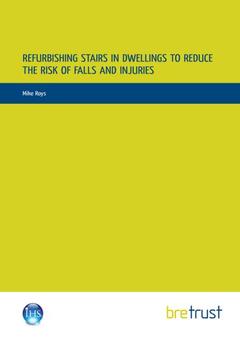Description
Refurbishing Stairs in Dwellings to Reduce the Risks of Falls and Injuries
Author: Roys Mike
Language: English
Subject for Refurbishing Stairs in Dwellings to Reduce the Risks of...:
· 21x29.7 cm · Paperback
Description
/li>Contents
/li>Readership
/li>Biography
/li>
More than 350,000 injuries and 550 deaths in the UK every year are caused by falls on domestic stairs and steps. Reducing the risks associated with the most hazardous stairs is relatively inexpensive, with a typical payback period of six years (based on savings for the health services).
This report considers the aspects of poor stair design that can be repaired or replaced in order to mitigate most of this risk. These include: handrail design, lighting, guarding, step covering, access and landings, step dimensions, step inconsistencies and non-straight stairs.
A stair assessment checklist provides a simple process for assessing domestic stairs, and includes some practical advice on such measures as installing handrails and making repairs. Three case studies illustrate some very poor stairs, and the short payback periods associated with their repair.




